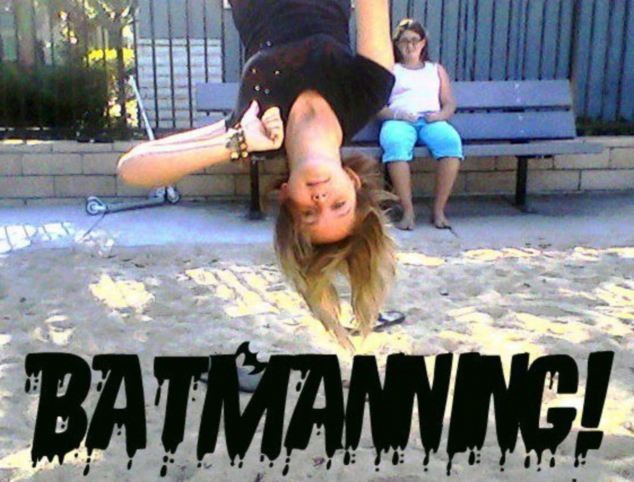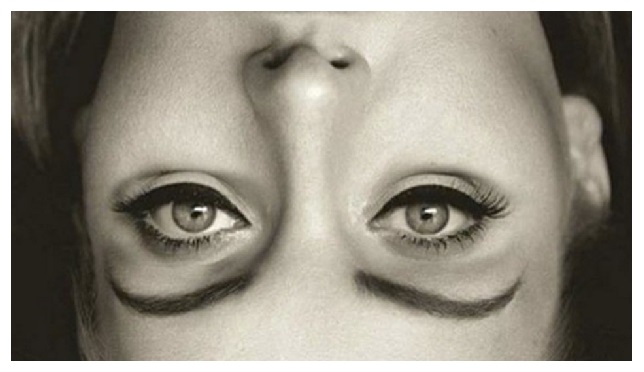
It might sound a bit odd, but apparently it’s possible to improve metabolic measures related to blood flow simply by hanging upside down. However, get it wrong and you might end up killing yourself.
It’s well-known that regular aerobic exercise is good for the heart. But various yoga positions also appear to do a similar trick without the need for so much sweating.
One particular yoga pose of specific interest is the upside down position. Of course, as you can see below, there are plenty of different ways of achieving this.
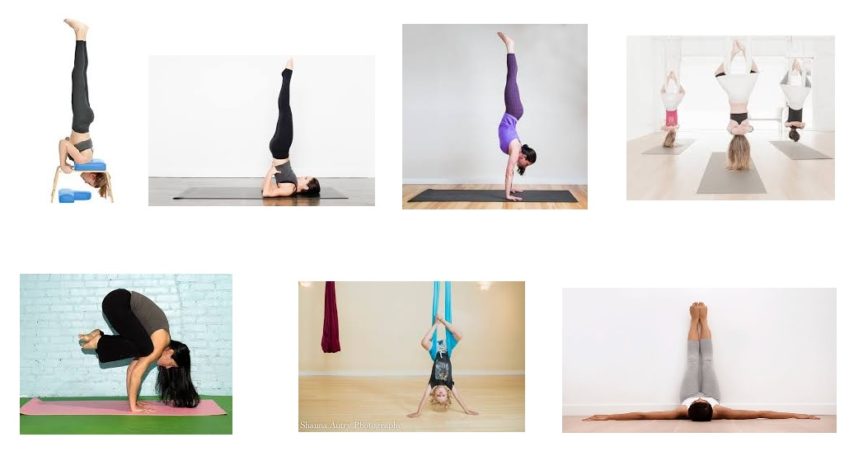
What are the upside down benefits?
A 2011 review 1 into the benefits of yoga in general considered that upside down (or inverted) yoga poses were of benefit to the cardiovascular system:
“Inverted poses encourage venous blood flow from the legs and pelvis back to the heart and then pumped through the lungs where it becomes freshly oxygenated. Many studies 2 3 4 show yoga lowers the resting heart rate, increases endurance, and can improve the maximum uptake and utilisation of oxygen during exercise.”
There are plenty of yoga websites 5 6 7 8 that give advice on the best way to achieve this inverted pose – variously called supported headstand, sirsasana, inversions, and so forth.
Any yoga’s good yoga
Naturally, this is not the only yoga pose that studies have shown has health benefits. Studies suggest a wide range of benefits, such as:
The list goes on and on…
Dying to be upside down

However, you should be warned that this is not one of those things where a little is good and a lot is even better. Too much inversion can kill 20 .
In 2009, a guy called John Jones, who lived in Utah, died after spending 28 hours stuck upside down in a cave 21 , most likely from asphyxiation.
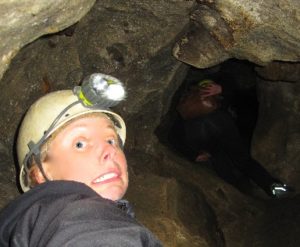
Upside down lungs
It transpires that our lungs evolved to sit on top of all the other organs for a very good reason. They are such delicate organs that it doesn’t take them long to get squashed by the larger and heavier organs such as the liver and intestines that usually sit below them. 22
This isn’t a problem for sloths, since they have their lungs “taped” to their ribs 23 .

But for us mere humans, having our heads directly underneath our feet for extended periods of time means that the lungs simply can’t absorb enough oxygen given the restricted space they have to work within.
Upside down brain
And it’s not just our lungs that have difficulty. Our bodies are set up to move blood around when we’re upright. Our blood vessels are customised to make sure blood doesn’t pool in our feet. This system is a “one-way street”, since our bodies didn’t evolve to prevent blood from pooling in the brain. This is patently not the case with bats. They have one-way valves in their arteries that prevent blood from flowing backwards. This is why they are able to hang upside down without the blood rushing to their heads 24 .

However, unlike bats, Batman would get into all sorts of vascular trouble (with or without the help of Robin) – ruptured blood vessels and potential brain haemorrhage included.
Upside down heart
And the heart is no lover of too much life down under 25 . It’s thought that heart failure accounts for most upside down fatalities. Just as with the brain, when the heart is above the head, it pumps more slowly and starts to receive more blood than it has the capacity to deal with at any one time. The result is that it begins to have a hard time maintaining blood pressure. Eventually, it will lose its ability to move sufficient blood around to maintain all the body’s essential functions.
Hanging around for too long will eventually kill you – a risk which increases as we age or if we are sick.
Inversion can be torture
It should be remembered that inversion was used as a torture method is ye olde days. It combined pain with a smattering of humiliation. Often the torture of choice for those sinners with unorthodox beliefs, it was used by the Romans with Christians and the Spanish with Jews and Muslims 26 27 . The Japanese even have a word for it – Tsurushi or “reverse hanging” 28 .
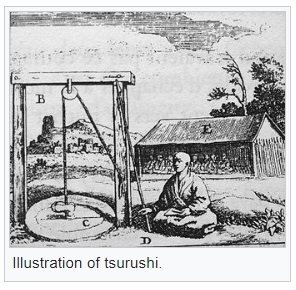
Nice to see how relaxed that monk-like executioner appears!
Another thing they used to do was to keep the victim inverted for some time and then make them stand upright again. Apparently, this is very painful as the blood pools to the feet again. Of course, they’re then hung upside down again. This process usually kills them within 8 to 10 hours.
Oh how inventive we humans are…
Final thoughts
It’s probably the case that any exercise is good exercise – whether it’s resistance training with weights, aerobic, or yoga. The important thing is to ensure you get plenty of regular daily exercise – either 90 mins low-moderate intensity (e.g. walking) or 45 mins of high-intensity exercise (e.g cycling, running, or rowing). It’s generally suggested 29 that you can work out your maximum heart rate by simply subtracting your age from 220. Then you can think of low-moderate intensity as being 50 – 70% of the resulting figure, whilst high-intensity would be 70-85%.
Spending a little time upside down appears to be something worth considering – however, some methods of achieving this are better than others…
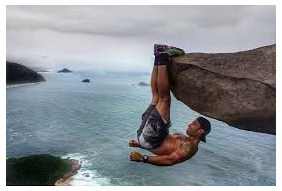
References
- Int J Yoga. 2011 Jul-Dec; 4(2): 49–54. Exploring the therapeutic effects of yoga and its ability to increase quality of life. Catherine Woodyard. [↩]
- Effect of yoga on cardiovascular system in subjects above 40 years. Bharshankar JR, Bharshankar RN, Deshpande VN, Kaore SB, Gosavi GB. Indian J Physiol Pharmacol. 2003 Apr; 47(2):202-6. [↩]
- Hatha yoga: improved vital capacity of college students. Birkel DA, Edgren L Altern Ther Health Med. 2000 Nov; 6(6):55-63. [↩]
- Effects of Hatha yoga and Omkar meditation on cardiorespiratory performance, psychologic profile, and melatonin secretion. Harinath K, Malhotra AS, Pal K, Prasad R, Kumar R, Kain TC, Rai L, Sawhney RC J Altern Complement Med. 2004 Apr; 10(2):261-8. [↩]
- Yoga Journal: Supported Headstand [↩]
- Yoga Journal: Everybody Upside-Down [↩]
- YouTube video: How to Do a Headstand (Sirsasana) Yoga [↩]
- DoYouYoga: 10 Most Popular Yoga Inversions [↩]
- J Clin Neurosci. 2017 Sep;43:61-67. doi: 10.1016/j.jocn.2017.05.012. Epub 2017 Jun 7. Evidence based effects of yoga in neurological disorders. Mooventhan A, Nivethitha L. [↩]
- PLoS One. 2014 Nov 12;9(11):e112414. doi: 10.1371/journal.pone.0112414. eCollection 2014. Yoga for multiple sclerosis: a systematic review and meta-analysis. Cramer H, Lauche R, Azizi H, Dobos G, Langhorst J. [↩]
- Cochrane Database Syst Rev. 2017 Dec 8;12:CD011483. doi: 10.1002/14651858.CD011483.pub2. Yoga for stroke rehabilitation. Lawrence M, Celestino Junior FT, Matozinho HH, Govan L, Booth J, Beecher J. [↩]
- Cochrane Database Syst Rev. 2017 Oct 5;10:CD001524. doi: 10.1002/14651858.CD001524.pub3. Yoga for epilepsy. Panebianco M, Sridharan K, Ramaratnam S. [↩]
- Trials. 2017 Nov 2;18(1):509. doi: 10.1186/s13063-017-2223-x. The effects of yoga versus stretching and resistance training exercises on psychological distress for people with mild-to-moderate Parkinson’s disease: study prxotocol for a randomized controlled trial. Kwok JYY, Kwan JCY, Auyeung M, Mok VCT, Chan HYL. [↩]
- Int J Geriatr Psychiatry. 2017 Jan;32(1):118. doi: 10.1002/gps.4538. The therapeutic effects of yoga in people with dementia: a systematic review. Du Q, Wei Z. [↩]
- Res Gerontol Nurs. 2014 Jul-Aug;7(4):171-7. doi: 10.3928/19404921-20140218-01. Epub 2014 Feb 26. The effect of chair yoga in older adults with moderate and severe Alzheimer’s disease. McCaffrey R, Park J, Newman D, Hagen D. [↩]
- Exp Clin Endocrinol Diabetes. 2016 Feb;124(2):65-70. doi: 10.1055/s-0035-1565062. Epub 2015 Nov 17. The Efficacy and Safety of Yoga in Managing Hypertension. Cramer H. [↩]
- Prev Med. 2016 Jun;87:213-232. doi: 10.1016/j.ypmed.2016.03.013. Epub 2016 Apr 4. A systematic review and meta-analysis on the effects of yoga on weight-related outcomes. Lauche R, Langhorst J, Lee MS, Dobos G, Cramer H. [↩]
- Prev Med. 2017 Dec;105:116-126. doi: 10.1016/j.ypmed.2017.08.017. Epub 2017 Sep 4. The effects of yoga among adults with type 2 diabetes: A systematic review and meta-analysis. Thind H et al. [↩]
- Depress Anxiety. 2013 Nov;30(11):1068-83. doi: 10.1002/da.22166. Epub 2013 Aug 6. Yoga for depression: a systematic review and meta-analysis. Cramer H, Lauche R, Langhorst J, Dobos G. [↩]
- Quora: How long could a human being survive hanging upside down if they’re being fed, hydrated, etc. Would spending one’s life hanging upside down shorten one’s lifespan? Amandi Dilshara. Oct 24 2019. [↩]
- ABC News: Man in Utah Cave Faced Tough Odds, Doctors Say John Jones’ upside down position in the cave left rescue workers little time. By LAUREN COX. Nov. 26, 2009. [↩]
- HowStuffWorks: How Your Lungs Work. BY CRAIG FREUDENRICH, PH.D. [↩]
- National Geographic: SCIENCE & INNOVATION. To Breathe Upside-Down, Sloths Tape Organs To Their Ribs. BY ED YONG. PUBLISHED APRIL 23, 2014. [↩]
- Bat Worlds: Bat Anatomy. Nov 5, 2013. [↩]
- How StuffWorks: How Your Heart Works. CARL BIANCO. [↩]
- The Marseille Tarot Revealed: A Complete Guide to Symbolism, Meanings & Methods. By Yoav Ben-Dov. [↩]
- Bustle: 7 Incredibly Disturbing Execution Methods From The Middle Ages (You Really Should Not Read This) By LARA RUTHERFORD-MORRISON. May 14 2015. [↩]
- Wikipedia: Tsurushi. [↩]
- Mayo Clinic: Exercise intensity: How to measure it. [↩]
